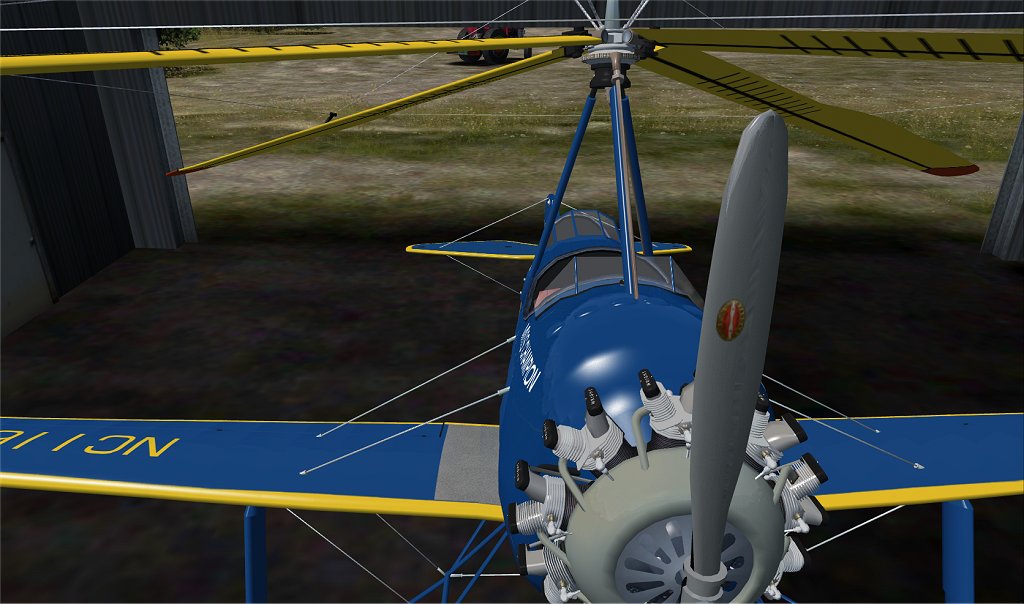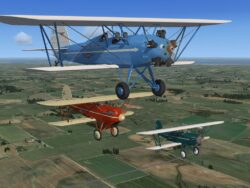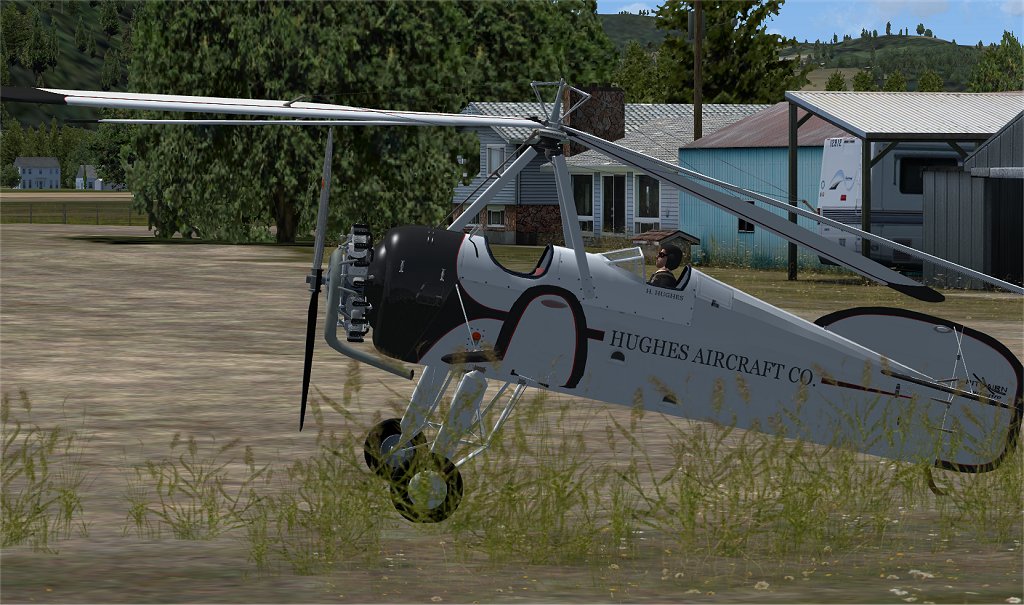he development of the autogyro began with a crash in Spain, in 1919. The plane was a Trimotor, the pilot a man called Juan De La Cierva, and the crash was the result of a stall. Unlike other aviators of that period, who accepted crashes as an occupational hazard, Cierva was inspired to look for a solution to the problem, with the result that by 1920, he was convinced that a rotating wing was the answer; but a host of technical problems had to be resolved. Given that the Wrights first flew in December 1903, it seems extraordinary that the first cyclic pitch design had been patented as early as 1906; that the first vertical free flight (to two feet) was made the following year; that the tail rotor was first proposed sometime around 1908; and that Igor Sikorsky built his first helicopter in Kiev in 1909; so although Cierva was a pioneer, he had plenty of data to work on. By the end of WW1, helicopters, although not exactly mainstream, were the subject of considerable interest, but it wasn't until the twenties that practical designs began to emerge, largely thanks to solutions being found to manage cyclic pitch control. The man who is generally recognised as achieving this was an Argentinian, the Marquis Paul Pateras Pescara, who was also one of the first people to show that autorotation could be used to safely reach the ground in the event of engine failure in a chopper - and it is possible that this is what caught Cierva's eye as he nursed his bruises from the Trimotor crash.
Pitcairn Mailwing Aircraft

Cierva's first autogyro flew, with its designer at the controls, on January 9th 1923 and he moved to England a couple of years later, where he established the Cierva Autogiro Company of Great Britain, which built and licensed his designs. By 1928, Cierva was confident enough to fly one of his machines across the Channel, before undertaking a three thousand mile tour of Europe, drawing appreciative crowds wherever he went. Something like five hundred autogiros were built and sold by Cierva, Avro, Focke-Wulf and others including Pitcairn in the US.
Pitcairn-Cierva Autogiro Company of America PCA-1A. In the late 1920's, Harold Pitcairn had established a sterling reputation as a builder of rugged biplanes used by airmail services. He had also founded what would eventually become Eastern Airlines. Yet by 1930, Pitcairn had begun dismantling these enterprises to support the highly speculative. Ran some testing this afternoon, figure Id share my results. The Concorde is a pig. Testing: Only thing that changed were the planes. Simple looking out the cockpit window sitting at Gate G14 at a loaded Miami City X KMIA with high FSX settings. Golden Age Simulations Greetings fellow enthusiasts of the Golden Age of Aviation inside Microsofts Flight Simulators.What we have here is a simple and what should prove to be a controversial Blog on My experiences creating developing and flying wonderful vintage aeroplanes coming out of our Factory at Golden Age Simulations.Also a general discussion and view on Vintage real world aviation. To the Pitcairn Autogiro Page: Click on image above to got to the Curtiss Jenny JN-4D Page: Click on image above to go to the B221A Page: Click on image above to go to the de Havilland88 Comet Page: Click on image above to go to the de Havilland80 Puss Moth Page: Click on image above to go to the DH91 location. Click on image above to go to the. This package showcases a completely new model of the autogiro, the Pitcairn PA-18 which has been designed from the ground up as a FSX native aircraft. Included in the package as well is the FSX Native version of our previously released PCA-2 for FS 2004 but in this case it was essentially taken apart and put back together to be fully compatible.
Harold Pitcairn bought the exclusive rights to build Cierva autogiros in the US in 1928, the first three rolling off the line the following year, one of them crashing with Cierva as pilot, although the man walked away unhurt from the wreckage. Various publicity stunts followed, with Amelia Earhart setting an altitude record for autogyros, after a climb to over 18,000 feet and a landing on the White House lawn during a ceremony in which President Hoover presented Cierva with an award. The military were showing interest by this stage and Cierva introduced a further refinement in the form of a tilting rotor head, but by the middle of the thirties, development of the helicopter had advanced to the stage where the autogyro's limitations were all too apparent and with Cierva's death in a crash in late 1936, the concept all but faded away, although interest in autogyros has never quite died. Autogyros saw limited usage during the Second World War, with Focke-Wulf designs being flown as spotters from a few U-boats and the Japanese also operated them, but post-war, autogyros have been a minority interest.
Apart from the fact that they use a horizontally-mounted prop to power forward flight, autogyros differ from helicopters in several ways that combine to limit their versatility. In the early days, 'ground resonance' was a real hazard, the phenomenon usually being caused by the shock of a hard landing unbalancing the rotor and causing the hull to flip unpredictably and this did a lot to discourage widespread adoption. Another problem is that, unlike a helicopter, it is all too easy to land an autogyro in an area that it can't be flown out of, because some sort of takeoff roll is always necessary; and neither can an autogyro hover for more than a second or so, not that most pilots would want to try such a thing, because directional control in an autogyro declines with decreasing airspeed. The real nail in the coffin of the autogyro is that its payload and speed are limited, making a helicopter or a conventional aircraft a more attractive solution in the majority of situations. Finally, Cierva's quest for safety never really reached fulfilment and few aviation authorities allow autogyros to operate without restrictions, but despite that, in sensible hands, they are a (relatively) cheap and stylish way of getting around and folk like Ken Wallis have flown them to fame, if not fortune, in films like You Only Live Twice. Ken will almost certainly disagree with me about the safety record of autogyros, but then he really knows how to fly 'em!
Golden Age have done flight simulation the great favor of specialising in packages simulating planes from the pre-war years and we reviewed their Travel Air pack a while ago; planes from this period are among the most interesting aircraft ever built and there is an almost inexhaustible supply of classics to go at. The Pitcairn autogiro is a 39 meg download from the Pilot Shop and comes at an attractive price, so it made an irresistible target for a review. Golden Age had just patched the sim up to version 1.2 at the time I downloaded it and it came down the link at seconds flat. You get five versions of the PCA-2 autogiro in the pack: Steve Pitcairn's 'Miss Champion'; Johnny Miller's 'Missing Link'; a crop duster; a 'Detroit News' livery; and a US Navy evaluation machine. The versions are well chosen: Steve's autogiro is the only flyable PCA-2 left, presently in the care of the EAA; while Miller flew his across the US and back in 1931, incurring an unexpected case of sunburn in the process, as he hadn't reckoned on the lack of protection from the elements. Miller was a very professional pilot and his flight time, transcontinental, was just under 44 hours - after his return, he used to amuse the crowds at airshows by doing loops in his PCA-2. Amelia Earhart attempted the same flight, by the way, but crashed shortly after takeoff in Abilene (she crashed two other autogiros before giving up on them).

The addon should run on any system that can run FSX, because it isn't any more complex than the default planes. I did the review on a 2.66 Ghz Core2Duo with 4 Gb of RAM and a 768 Mb GeForce 8800GTX, using FSX SP1 on Windows Vista. At the end of installation you are treated to a brief view of the manual, which runs to three pages - more than enough to tell you all you need to know about flying the sim. The installation doesn't create a new program group, but the manual can be found in ...Program FilesMicrosoft GamesMicrosoft Flight Simulator XGolden Age Simulations, as can the pdf which describes how to install a small addon scenery included with the package. This is Camden Airport, New Jersey, as it was in the glory days of the PCA-2 and as far as scenery is concerned, it works fine, although I had problems with the runway textures flashing on and off, so I suspect it has not been optimised for FSX. The manual talks about a mail run mission, but if it is there, I couldn't find it on my installation.

The visual model of the autogiro is great and conveys just what an odd-looking enterprise the Ciervas were, with their stub wings, wire-braced gear and things whirring around all over the place. Just about the only things that resemble thirties autogyros are items of thirties farm machinery and I sometimes wonder if Cierva got his idea from watching combine harvesters at work! The textures are good, the only problem being that the reflective shine is a little bright. Apart from that, there isn't much to say, other than the engine and rotor head are nicely detailed and there aren't many animations because there is hardly anything to animate, apart from a blue exhaust flame. The crop sprayer will trail spray in FSX, but when I hit the I key, the trail appeared to one side of the autogiro, rather than behind it.

The Pitcairn has a 2D panel and a virtual cockpit (VC), but it is so kind to frame rates that there isn't much reason to use the former. As far as instruments go, you get the basics and that is it - apart from the standard six, there is oil temp and pressure, cylinder head temperature and a voltmeter - but you also get some extra controls, in the form of a rotor brake and clutch, the autogiro being flown with a standard stick and rudder. The VC is up to the standard of the default planes and although the color changes correctly with each version, the contours of the glareshield and panel are a bit more angular than I would have hoped.
Flying the Pitcairn is a piece of cake, as long as you don't forget that you aren't in a chopper. All takeoffs should be into wind and as soon as you have forward speed, all you have to do is push the stick forwards, then pull it gently back and climb away - the run is amazingly short, perhaps only a few yards and maybe 30 or so in absolutely calm conditions. Landings are even easier, because all you have to do is to idle the engine and pitch the autogiro to maintain between 35 and 40 mph. If you look as if you are going to land short, add more power; the only thing you can't do is to keep pitching the nose up if you are going to overshoot, because the blades stall at 20 mph and you will end up in a heap like Amelia did. A blip of the throttle in the flare helps cushion your arrival and that is it - no flaps, no high lift devices, no nothing. With care it is possible to do loops and barrel rolls, but you have to maintain positive G throughout and it takes a little practice.
Pitcairn Aircraft

Verdict? Another neat package from Golden Age, illuminating a piece of aviation history that would have passed most simmers by, but for this developer's dedication to the age of discovery. Sure, the addon isn't perfect and it does have the feel of an FS2004 sim that has been repackaged for FSX, but a few minor bugs aside, it is in a class of its own and at the price, it adds up to a really different and fun approach to the virtual sky.
Pitcairn Autogyro History
Andrew Herd
[email protected]
Learn More Here